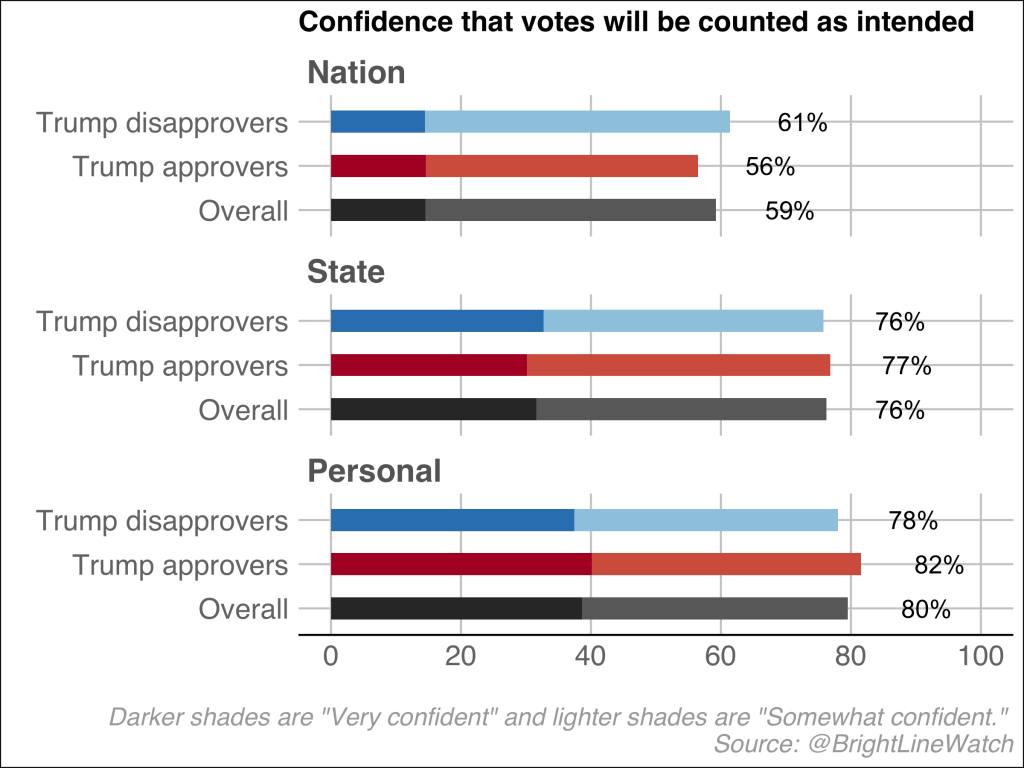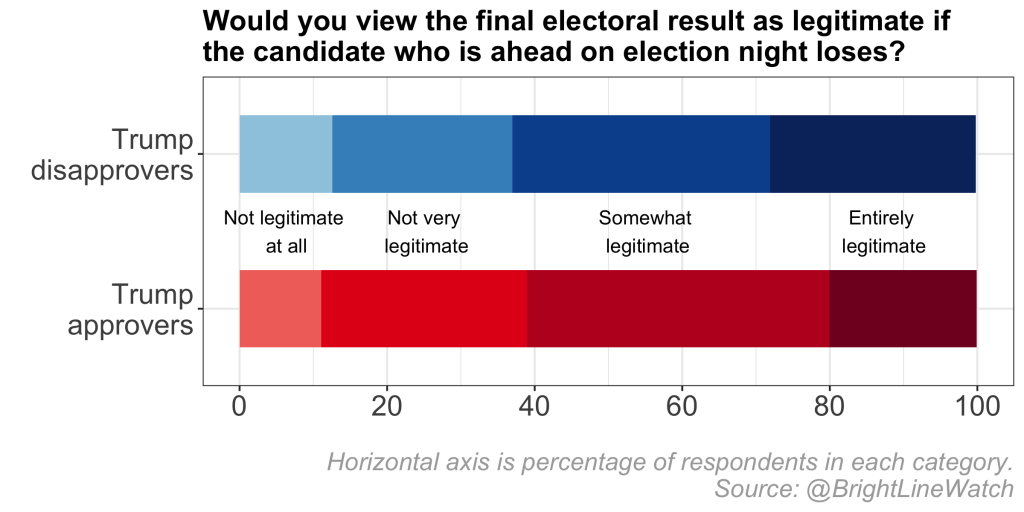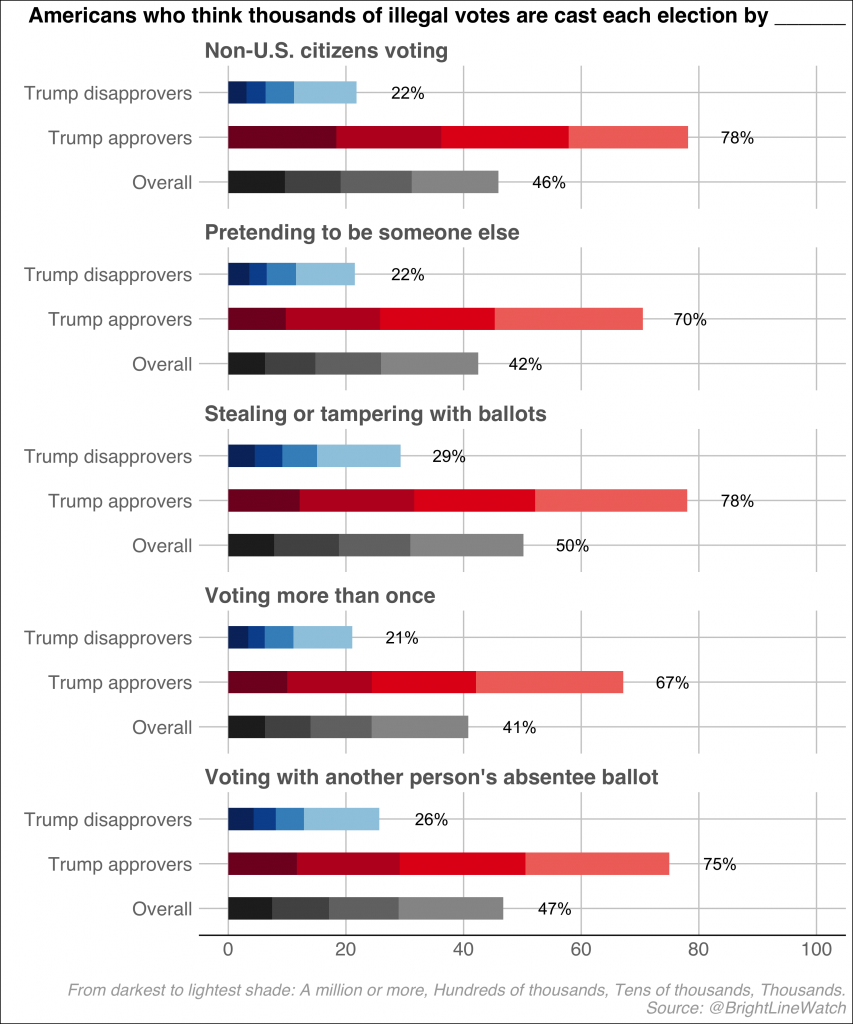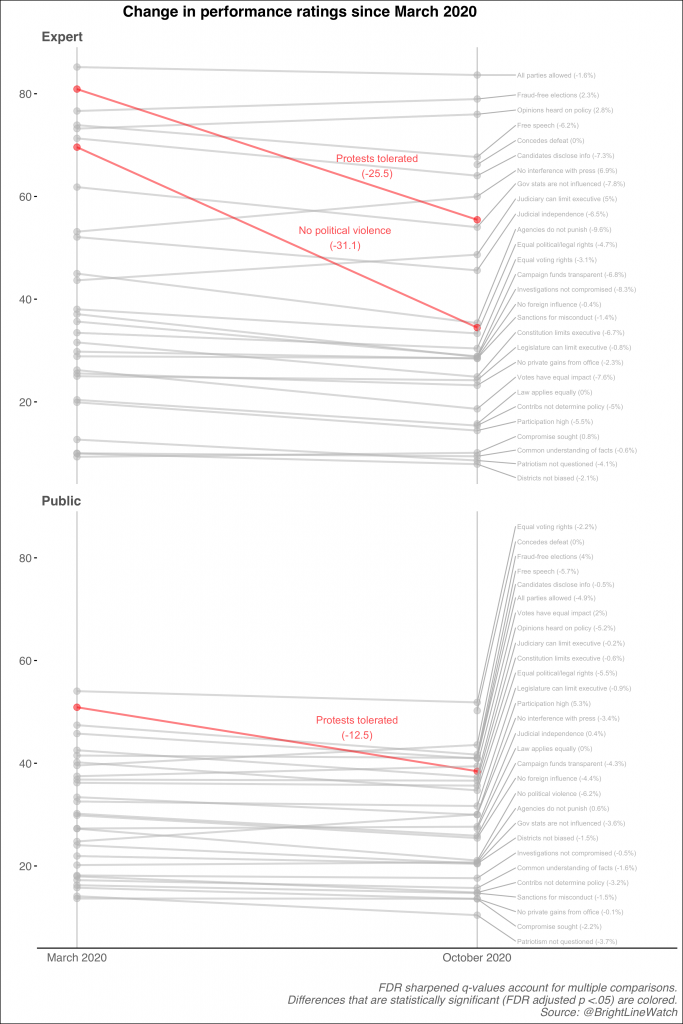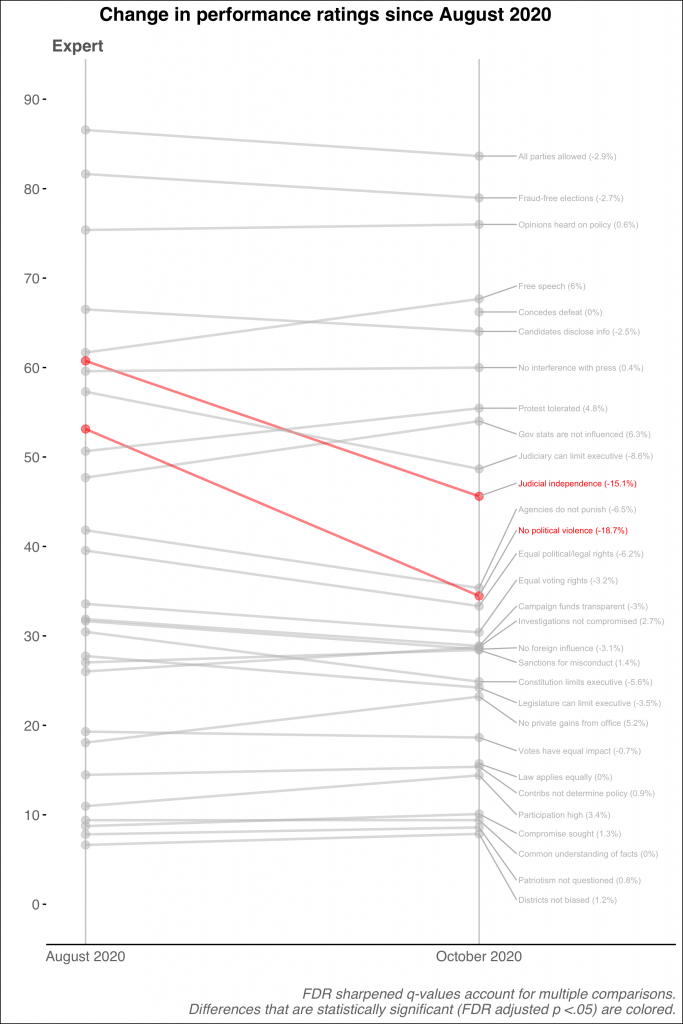American Democracy on the Eve of the 2020 Election
Bright Line Watch October 2020 surveys
As the 2020 election approaches, news stories with implications for U.S. democracy have dropped at a dizzying rate. Supreme Court Justice Ruth Bader Ginsberg died and President Trump quickly announced he would seek to confirm a replacement “without delay.” The New York Times published new details of Trump’s tax and financial history. The country endured a presidential debate called the “worst in living memory” in which the president frequently refused to let his opponent speak uninterrupted, failed to condemn white supremacist groups when asked to do so, falsely attacked the integrity of the election, and refused to commit to accepting the election’s result if he lost. Then the country learned that President Trump had tested positive for the novel coronavirus along with numerous other executive branch staff and elected officials who attended a White House event announcing the president’s Supreme Court nominee, Judge Amy Coney Barrett.
In this context, Bright Line Watch fielded parallel surveys of political science experts and of a representative sample of Americans from October 5–16. As in previous surveys, we asked each group to assess the quality of U.S. democracy overall and to rate performance on 30 distinct democratic principles. For this pre-election survey, we also asked our experts to rate the likelihood of 28 scenarios related to the November election that could produce political crises and asked our public sample questions about the legitimacy of different election results, their confidence votes will be counted fairly, their beliefs about voter fraud, and their willingness to tolerate political violence.
We report a number of key findings below:
- Our expert respondents anticipate a flood of online misinformation and potentially destabilizing rhetoric from President Trump during and after November 3. They also see substantial risks of other scenarios that could threaten the election, including potential dysfunction in the mechanics of casting and counting votes, the Electoral College, and the resolution of electoral disputes.
- Our experts rate President Trump’s statement that the 2020 election should be delayed and his refusal to commit to a peaceful transfer of power as the most important and abnormal of the 169 events they have rated over the course of his presidency.
- Citizens are generally confident their votes will be counted as intended at the local level and as voters intend in their states but somewhat less confident in the process at the national level.
- Only 44% of Trump supporters say they would regard a Biden victory as legitimate and only 34% of Trump opponents said they would view a Trump victory as legitimate.
- Both supporters and opponents of President Trump recognize that the election result may not be clear on November 3. Majorities of both groups say they are prepared to recognize outcomes that differ from the initial count on Election Night as legitimate.
- Trump’s supporters and opponents have starkly different beliefs about the prevalence of voter fraud in U.S. elections.
- Most Americans, regardless of political affiliation, reject the use of violence to advance political goals, but substantial minorities are willing to condone violence and incivility.
- Americans’ confidence that their government protects them from political violence and guarantees their right to peaceful protest have declined since March.
We present the results from our surveys in two parts. First, we offer forward-looking results that describe how our expert and public respondents view the election ahead — expert ratings of the likelihood of various nightmare scenarios and public confidence that the election will be procedurally fair and free of fraud and violence. We then examine how public and expert assessments of the state of U.S. democracy changed since prior surveys and how our experts judge the importance and normality of recent events.
Nightmare scenarios
In recent months, experts and scholars have warned of scenarios in which the election creates a crisis for democratic institutions. These contingencies have attracted substantial attention in the news media. However, discussion of these scenarios often proceeds without reference to their likelihood in either relative or absolute terms.
We therefore asked experts to rate the likelihood of scenarios that have been proposed like the following:
- “The Department of Justice seeks to block the counting of mail-in ballots.”
- “One or both presidential candidates declare victory before the race has been called by the Associated Press.”
- “President Trump is declared the loser of the election by the Associated Press but refuses to immediately concede defeat.”
- “One or more legal disputes over the election are decided by the U.S. Supreme Court.”
Each expert participant saw a random subset of 12 of the 28 scenarios and was asked to predict their likelihood from 0% to 100%. (The full set of statements is included in the Appendix to this report.)
The figure below reports the median probability estimate and the density of probability estimates across the available range of 0% to 100% for each scenario among our expert respondents. Items are listed in descending order of estimated median likelihood. The scenarios are grouped in terciles with the density plots of the highest probability group concentrated on the right-hand side of the scale and shaded red. Those of the middle group, which are widely dispersed, are shaded orange. The longshots, which have estimates concentrated on the left-hand side, are shaded yellow.
We first note that median expert estimates for the scenarios, which range from 5% to 94.5%, are higher than expected, particularly for some which seem extremely unlikely — for example, a faithless elector being pivotal (10%), an acting president being appointed under the 20th Amendment (18.5%), or millions of counterfeit ballots being distributed by mail (5%). The tendency to overestimate the probability of these scenarios may reflect people’s tendency to overestimate the likelihood of low-probability events or other psychological factors such as availability bias. However, scholars have shown that even when experts’ forecasts are too high or too low in general, they can still reliably predict which probabilities are higher or lower than others. This ability to distinguish among relative probabilities, which is called discrimination, is what we focus on below. In that sense, our data should provide an indication of what risks the experts see as more or less likely than others and therefore help us to prioritize our attention over the next few weeks.
Within the higher probability group, the scenarios rated as most likely concern potential problems on Election Day such a proliferation of false claims on social media about election integrity and long lines and delays at the polls. Also near the top are a cluster of items related to President Trump — that he will decry an anticipated “blue shift” as ballots are counted, insisting that the initial totals on Election Night were correct; that he will encourage violence and intimidation during voting or ballot counting; and that he will refuse to concede the election after having been declared to have lost by the Associated Press. The next three items focus on the mechanics of vote counting, a challenge in an election in which unprecedented numbers of votes will be cast by mail and a subject of political controversy given the President’s repeated attacks on mail balloting.
Our experts expect that the disqualification of mail-in ballots will surpass 5% in at least one state, that early vote counts (which are expected to underrepresent mail ballots) will lean Republican, and that at least one candidate will declare victory before the Associated Press regards the outcome as sealed. Finally, our expert respondents see it as likely that Trump would seek to negotiate legal amnesty after the election (presumably after a loss).
Scenarios in the middle category concern other potential election administration failures; interventions in the election process by Trump or federal actors; and legal changes or disputes related to the election. Some focus on the mechanics of voting and counting at the state level, including the potential for widespread closure of polling places, a delay of at least one million ballots in the mail, and vote counting delays and other state-level disputes causing at least one state to miss the “safe harbor” deadline of December 8 for selecting its presidential electors. Other scenarios in this set involve Trump or other federal officials deploying force during or after votes are cast and the Department of Justice seeking to block the counting of mail-in ballots. Another set of items in this set concerns potential disruptions to the Electoral College, including one or more states sending competing slates of electors, abandoning the popular vote as an allocation mechanism, a conflict between the Speaker of the House and the Vice-President over the tally of electors, or the Supreme Court deciding a dispute related to the election.
Finally, experts rated some events as long shots, though all of them would create substantial disruptions if realized. This set includes more dramatic challenges to conventional practices in the Electoral College: a state changing its allocation procedure away from winner-take-all (the current rule in 48 states) to district-by-district allocation, a faithless elector deciding the election outcome, or Joe Biden seeking to overturn an Electoral College loss in which he wins the popular vote. This set also includes “unexpected president” scenarios in which at least one party replaces its candidate, President Trump temporarily turns over power to Vice-President Pence, or an unresolved conflict over the Electoral College prompts appointment of an acting president under the 20th Amendment to the U.S. Constitution. Finally, this low-probability set includes two scenarios concerning foreign interference in the election — Russia hacking the voter registration or election systems in one more states or millions of counterfeit ballots being mailed to U.S. voters from abroad. Our experts are seemingly more preoccupied by domestic dysfunction than foreign disruption.
On the whole, our experts’ assessments are not reassuring. They see scenarios in which mainstream news and social media are flooded with false and irresponsible messages, election administration failures are widespread, and the President refuses to concede if defeated as most likely. They also give some credence to the potential for serious legal disputes over the election and federal interference in the process. However, they rate substantial foreign interference, a Biden campaign against the Electoral College, or an unexpected president as longer shots.
The public’s view of the election
We also asked our public respondents a series of questions designed to gauge their confidence in the upcoming election, their views of possible election outcomes, their beliefs about the prevalence of voter fraud, and their willingness to tolerate or support political violence.
Confidence in the ballot and the count
We first asked public participants how confident they are that everyone who is legally entitled to vote and seeks to do so will be able to do so. Overall, 74% of respondents indicated that they were very or somewhat confident in universal ballot access. However, approvers of President Trump were more sanguine than disapprovers (85% versus 65%; see Figure A3 in Appendix).
We then asked respondents about their confidence that their own vote would be counted as they intend, that votes in their state would be counted as voters intend, and that votes nationwide would be counted as voters intend. The results are illustrated in the figure below, which distinguishes between Trump approvers and disapprovers. Large majorities are confident that their own votes will be counted accurately, with little difference between Trump supporters (82%) and opponents (78%). Confidence is slightly lower in state-level counts. However, we again see no discernible difference across the political divide. At the national level, however, confidence drops substantially. Only 59% of Americans express confidence that votes will be counted as voters intend nationally. These numbers vary slightly by Trump approval; the President’s supporters are somewhat more skeptical (56%) than his opponents (61%).
We can gain more insight into the sources of confidence in electoral administration by considering how partisan control over state governments affects responses. We place each state into one of three categories: Democratic control, Republican control, or split party control according to whether the same party controls the governorship as well as both chambers of the state legislature (or in Nebraska, the single chamber). Among our respondents, both Democrats and Republicans express the strongest confidence when their own party fully controls their state government, less confidence under split control, and weakest confidence when the other party holds the reins. Independents, fittingly, express strongest confidence in states under split party control. Notably, confidence among Republicans is far more sensitive to partisan control than among Democrats. Among respondents who identify as Democrats, the confidence difference in a state fully controlled by their own party (86%) is 8 points higher than in a state fully controlled by Republicans (78%). Among Republicans, the corresponding confidence gap is 22 point — 91% in a state controlled by co-partisans compared to 69% in one controlled by Democrats.
Looking ahead to November’s vote count, the only presidential battleground state with full Democratic control is Nevada. There, Republicans’ lack of faith in Democratic electoral administration could prove politically contentious. By contrast, a number of battlegrounds, including Florida, Georgia, Ohio, and Iowa, have full Republican control. Vote counts that are close and contested in those states, in particular, may test the faith of Democratic voters in their partisan adversaries.
Legitimacy
To probe their willingness to accept specific election outcomes, we asked each public participant in our survey whether they would regard each candidate as the rightful winner of the presidential election if that candidate should be declared the victor (with their order randomized). Unsurprisingly, Trump approvers overwhelmingly said they would view him as the rightful winner if he won (95%). Similarly, those who disapprove of Trump say they would see Biden as the rightful winner if he won (93%). However, only 44% of Trump approvers say they would regard a victorious Biden as the rightful winner and only 34% of Trump disapprovers would see Trump as such (see Figure A4 in the Appendix). Among each group of respondents, the gaps in their willingness to recognize the prospect of a legitimate opposition win are vast and troubling.
We also asked participants how they would regard a win by a candidate who was behind after preliminary vote counts reported on election night, a prospect that has worried commentators. On this count, responses were reassuring; solid majorities indicated they would regard a winner who was initially behind on election night as either somewhat or entirely legitimate. Strikingly, differences between Trump supporters and opponents were limited as illustrated in the figure below.
Incidence of voter fraud
President Trump has made an unprecedented stream of allegations that the election is fraudulent or rigged. These claims are false — voter fraud is vanishingly rare — but may be affecting public opinion. We therefore asked respondents about the prevalence of five different forms of fraud: voting by non-citizens, voting under a false identity, stealing or tampering with ballots, voting more than once, and voting with another person’s absentee ballot. Responses are illustrated in the figure below, which shows the percentage who indicated believing that thousands of illegal votes or more are cast that way in each election. (Participants selected from the following options: “Less than ten”; “Less than a hundred”; “Hundreds”; “Thousands”; “Tens of thousands”; “Hundreds of thousands”; “A million or more”.)
The figure underscores the vast partisan divide over voter fraud. The percentage of Americans who believe that thousands of each type of illegal votes are cast in elections ranges from 41% to 50% overall. However, it never rises above 29% among those who disapprove of President Trump, whereas the percentages range from 67% (voting more than once) to 78% (non-US citizens voting, and stealing or tampering with ballots) among Americans who approve of Trump. The average gap between Trump’s supporters and opponents on these items is 50 percentage points.
Toleration for violence
Finally, we consider how the public views potential political violence, which has come to be seen as a risk during this incredibly heated campaign. Borrowing from questions created by the political scientists Nathan Kalmoe and Liliana Mason, we asked our respondents about whether it is ever justified to harass partisan opponents online, send a threatening message to an opposing party leader, use violence to advance one’s goals (generally), use violence if the other party wins the 2020 election, or use violence if the other party uses it during the election. 
Reassuringly, a majority of each subgroup and Americans overall say it is never acceptable to engage in these behaviors. But political violence can degrade democracy without popular support. The figure shows reason for concern as non-trivial minorities indicate a willingness to condone incivility and violence. On each item, willingness to support incivility, harassment, and violence are higher among President Trump’s supporters than among his opponents. Notably, 23% of respondents, including 26% Trump approvers and 21% of opponents, condone violence in response to an opposing party’s electoral victory. These numbers skyrocket if partisan opponents use violence first. In that case, 40% of all respondents, including 46% of Trump supporters and 36% of Trump opponents, regard retaliatory violence as justified at least occasionally. These numbers are worrisome given the potential of social media and cable news to quickly amplify cases of political violence across the country, which could both encourage copycat behavior as well as prompt support for retaliation.
Performance of democracy
As in previous surveys, we also asked our respondents — both expert and public — to assess the quality of U.S. democracy overall on a scale of 0 to 100 and to evaluate its performance on 30 distinct democratic principles (including two new items on equal enforcement of the law and respect for election outcomes; see Appendix for wording). The figure below shows mean responses on the 0–100 scale for experts, the public overall, Trump supporters, and Trump opponents. Since March 2020, the rating of every group has declined at least somewhat. The mean rating has dropped among experts from 63.4 to 60.6; from 54.1 to 53.1 among the public overall; from 61.2 to 60.4 among Trump supporters; and from 48.7 to 48.1 among opponents. Looking back further to when Bright Line Watch began its surveys in 2017, these ratings show a pattern of gradual decline. (We anticipate the potential for substantial shifts, however, in the wake of the November election.)
Performance on 30 democratic principles
Our last joint elite/public survey was fielded in March 2020, but we also surveyed our expert sample in August 2020. We therefore first consider how experts’ perceptions have shifted since August. In Figure A5 in the Appendix, we show that the percentage of respondents indicating that the U.S. “mostly” or “fully meets” the standard in question dropped precipitously on two items: independence of the judiciary (down from 61% to 46%), and the protection of citizens from political violence from private actors (from 53% to 34%). We understand the first change as a likely response to the death of Supreme Court Justice Ruth Bader Ginsburg in September and the subsequent rush by the Trump administration and Senate Republicans to put a replacement on the bench. Our expert respondents appear to regard these events as indicating (further) politicization of the Court, particularly in light of the Republican stonewall against Judge Merrick Garland’s nomination in 2016.
The sharp decline in expert perceptions that the government effectively prevents private actors from engaging in politically-motivated violence or intimidation also seems linked to recent events. The period since our last survey was marked by shocking incidents of politically-motivated violence by private actors, including the alleged shootings on August 25 by self-styled militia member Kyle Rittenhouse at protests following the police shooting of Jacob Blake in Kenosha, Wisconsin, as well as a shooting in Portland, Oregon, of a pro-Trump protestor by Michael Forrest Rienoehl, who had publicly expressed support for antifa, and who was subsequently killed by law enforcement. Finally, while our survey was in the field, the FBI charged 6 men, and the state of Michigan 7 others, in a plot to kidnap Michigan Governor Gretchen Whitmer, a Democrat who has come under sustained attack for her policies related to the COVID pandemic.
Taking a longer view, the figure below illustrates changes in perceived democratic performance between the March and October 2020 survey waves for both the expert and public samples. Over this time frame, both groups perceive a decline in protection for the right to peaceful protest and experts perceive a decline in protection from political violence (the public shift is substantively large at 6.2 percentage points but just short of statistical significance). These shifts are likely a response to the massive wave of public protests that began after the killing of George Floyd by Minneapolis police in May and the violence that accompanied them. Though most protests were peaceful, there were in some instances rioters and looters within the ranks of protesters. In other cases, violence was initiated by counterprotestors. In addition, police and agents of the federal government often met protests with violence.
The importance and normality of events in August and September 2020
As in prior surveys, we asked our experts to separately assess the importance and normalcy of notable events that took place since our last report in August. Results are presented in the figures below. The events of greatest concern are those situated in the upper-right quadrant. These events are ones that experts deem highly unconventional and consequential; these are often major departures from democratic norms. In this survey, in particular, numerous events we asked about fall in this region.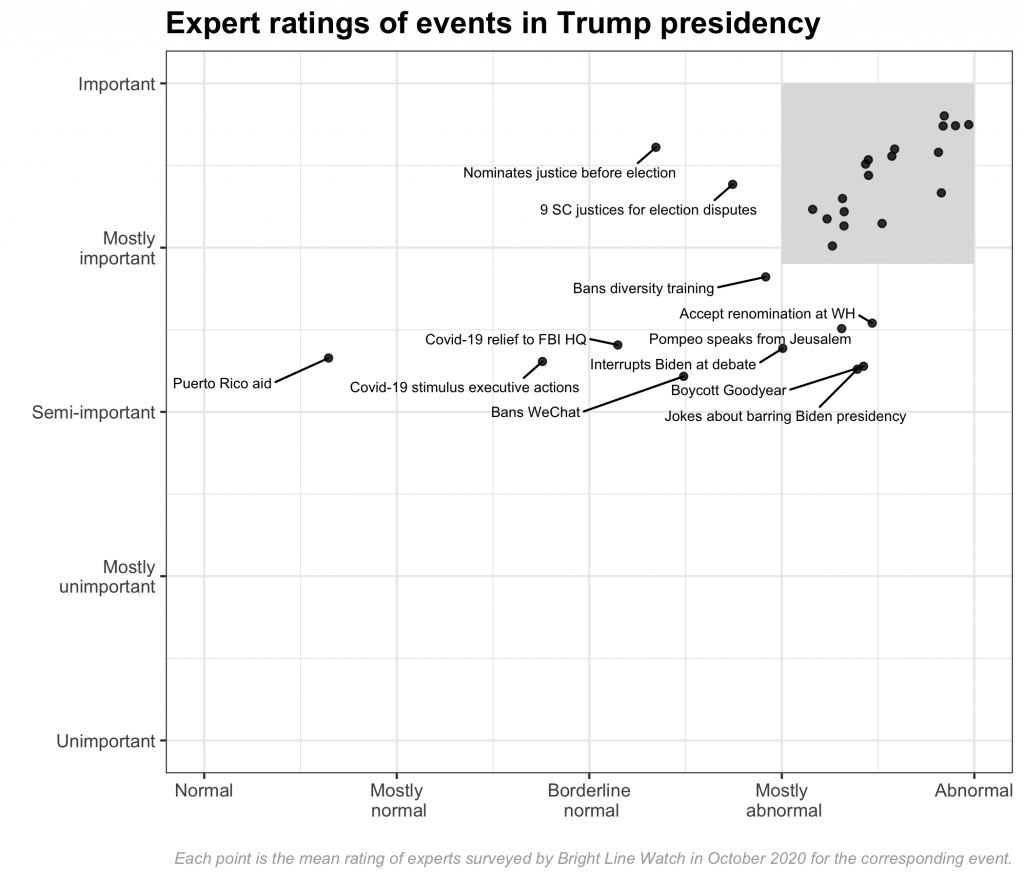
The figure below therefore provides a magnification of the top right sector highlighted in gray above, labeling the densely clustered items (labels in black) and superimposing them against items rated in that same top right sector from previous survey waves.

Most strikingly, the October 2020 survey finds four events crowded into the furthest top right corner of the chart, where the highest combined levels of abnormality and importance are represented. The previous outlier events in this region were the July 2018 summit meeting in which President Trump took Russian President Vladimir Putin’s side in dismissing U.S. intelligence findings that Russia had interfered in the 2016 U.S. election and Trump’s April 2019 phone call to Ukrainian President Volodimyr Zelensky, which eventually triggered Trump’s impeachment. In our most recent survey, two items are located northeast of the Putin summit: President Trump’s refusal to commit to a peaceful transition of power should he lose the election and his suggestion to delay the election altogether. Trump’s baseless claims that mail-in ballots will “totally rig” the 2020 election are rated as even more important than these claims and nearly as abnormal. The figure provides a strong signal that our experts think that President Trump’s public statements questioning the legitimacy of the 2020 election and refusing to commit to a peaceful transfer of power constitute a genuine crisis of U.S. democracy.
Appendix
Figure A1

Figure A2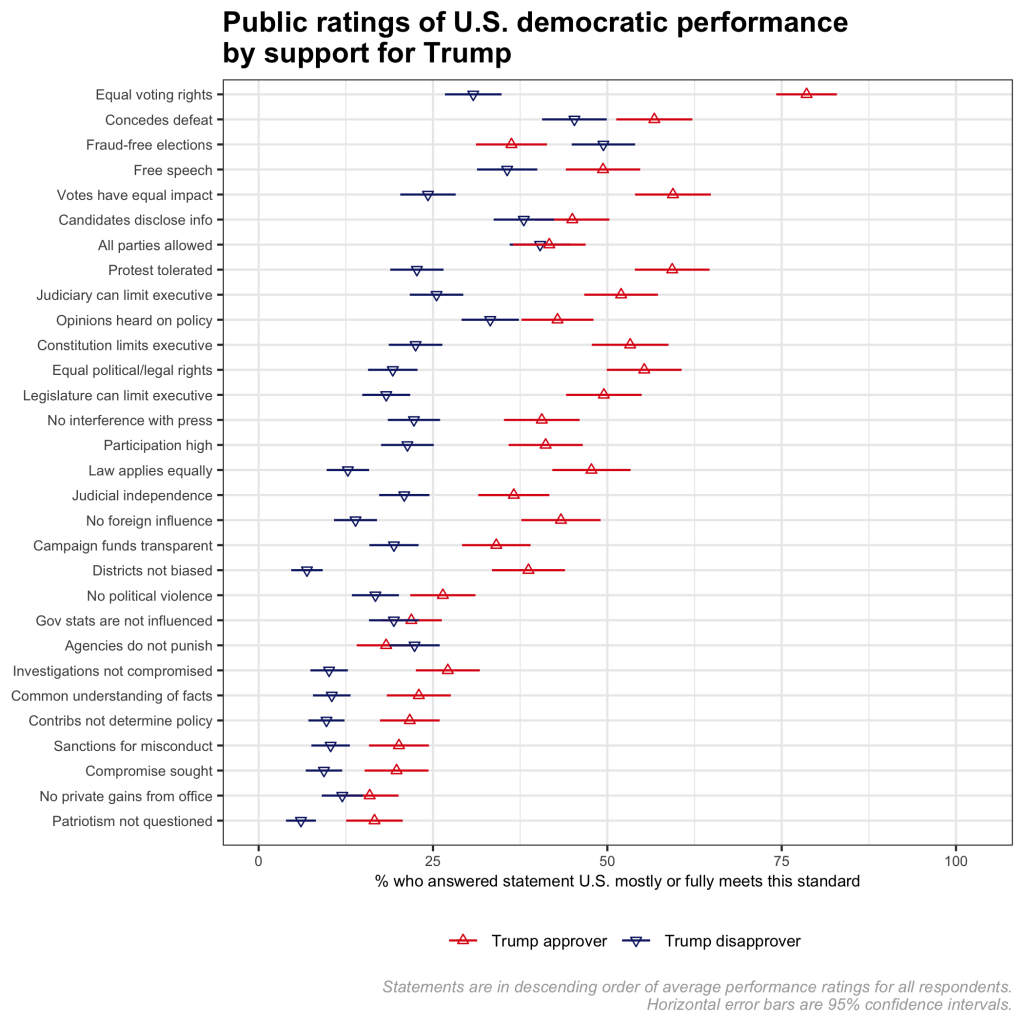 Figure A3
Figure A3 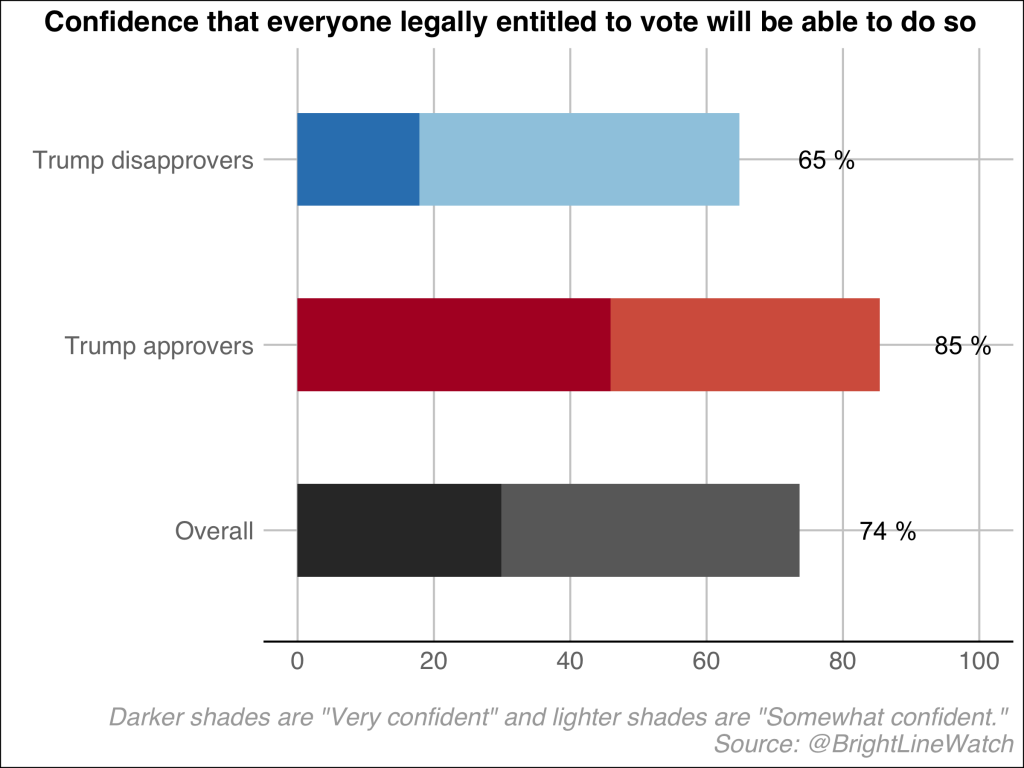
Figure A4
Figure A5
Bright Line Watch surveys on the state of America’s democracy, October 2020
From October 5–16, 2020, Bright Line Watch conducted its twelfth survey of academic experts, and ninth of the general public, on the quality of democracy in the United States. Our public sample consisted of 2700 survey participants from the YouGov sample who were selected and weighted to be representative of the U.S. adult population. We also surveyed 738 political science experts across a diverse range of subfields (7% of solicited invitations). Our email list was constructed from the faculty list of U.S. institutions represented in the online program of the 2016 American Political Science Association conference and updated by reviewing department websites and job placement records from Ph.D. programs in the period since.
All estimates shown in the report used weights provided by YouGov. Our expert sample is traditionally unweighted because we do not collect demographic data to protect anonymity. Error bars in our graphs represent 95% confidence intervals. Data are available here.
Both the expert and public samples in Wave 12 responded to a battery of questions about democratic performance in the United States (see below). Afterward, they were asked to evaluate the quality of American democracy overall on a 100-point scale. Experts were also asked to evaluate the quality of democracy in their state and several other states they identified as having particularly high or low quality. Expert respondents were then asked to respond to two additional batteries: one in which they were presented with a list of political events and asked to rate them on normalcy and importance and another which they were asked to evaluate hypothetical scenarios related to the upcoming election (lists of both are provided below).
Nightmare scenarios
- Russian hackers cripple voter registration and election systems in one or more states.
- Stay-at-home orders prevent voters from going to the polls on Election Day in one or more large cities (250,000+).
- Millions of Americans are exposed to false claims about voter fraud and election integrity on social media from unknown or obscure sources on Election Day.
- One or both presidential candidates declare victory before the race has been called by the Associated Press.
- More than one thousand planned polling locations consolidate or shut down nationwide on Election Day due to poll worker shortages.
- Tens of thousands of voters are still in line when polls are scheduled to close in at least one state due to long lines and delays on Election Day.
- Postal service delays cause more than one million mail ballots sent by voters to not be delivered to election officials in time to be counted.
- President Trump attacks the “blue shift” toward Democrats as mail votes are counted, insisting that the initial totals on Election Night were correct.
- Interim Election Night totals understate Democratic votes, creating widespread suspicion of the results.
- President Trump is declared the loser of the election by the Associated Press but refuses to immediately concede defeat.
- President Trump makes statements or posts tweets encouraging violence and intimidation during voting or ballot counting.
- President Trump deploys federal law enforcement or the military during voting or ballot counting.
- The Department of Justice seeks to block the counting of mail-in ballots.
- President Trump attempts to negotiate legal amnesty for himself and his family after the election.
- One or more states switch from the winner-take-all format to district-by-district allocation of presidential electors.
- One or more states send competing slates of electors to the Electoral College.
- One or more states are unable to resolve an election dispute before the safe harbor deadline.
- A dispute over the results of the election creates a conflict between the Vice President and the Speaker of the House over accepting Electoral College votes.
- A conflict over Electoral College votes causes the appointment of an acting president under the terms of the Twentieth Amendment on January 20, 2021.
- One or more legal disputes over the election are decided by the U.S. Supreme Court.
- One or more state legislatures enact a bill that would overturn the statewide popular vote as an allocation mechanism for electors and/or stop the counting of ballots.
- 5% or more of ballots cast by mail are rejected in one or more states.
- Biden seeks to overturn an apparent defeat in the Electoral College after winning the popular vote.
- Millions of counterfeit ballots are mailed to Americans from a foreign county.
- A faithless elector decides the presidency.
- The presidential election is decided by the House of Representatives.
- The RNC or DNC selects a replacement candidate for president before Election Day.
- President Trump temporarily turns over duties to Vice President Pence at least once.
Events
- Trump repeatedly interrupts Joe Biden at first presidential debate.
- Trump says far-right Proud Boys group should “stand back and stand by” after being asked if he will disavow white supremacists.
- Trump says the election might be “fraudulent” during the first presidential debate.
- The Justice Department intervenes on Trump’s behalf in E. Jean Carroll defamation lawsuit.
- President Trump accepts renomination in front of the White House.
- President Trump claims the election will be “totally rigged” if mail-in ballots are allowed.
- Senate Republicans allocate $1.75B from COVID relief bill to build FBI headquarters.
- President Trump signs executive actions after COVID stimulus talks break down.
- President Trump suggests supporters should try to vote twice.
- President Trump suggests the 2020 election should be delayed.
- Pentagon training course refers to protesters and journalists as “adversaries.”
- President Trump refuses to commit to a peaceful transition of power if he loses.
- The Director of National Intelligence cancels in-person election briefings for Congress.
- President Trump calls incident of reporter getting hit with a rubber bullet “law and order”
- President Trump jokes about signing executive order barring Biden presidency.
- President Trump calls for Goodyear boycott after company bans MAGA attire.
- The Secretary of Health and Human Services bans health agencies from issuing new rules.
- The Trump administration bans WeChat from US app stores.
- President Trump states that the Supreme Court needs nine justices, including his nominee, to handle election disputes.
- President Trump blames California for wildfires and threatens to withhold federal funds.
- The Postmaster General implements measures that cause delays in mail delivery.
- President Trump approves $13 billion in aid for Puerto Rico.
- President Trump bans diversity training in the federal government.
- President Trump seeks to nominate and confirm a new Supreme Court justice weeks before the election.
- President Trump suggests deploying law enforcement officials to monitor polls.
- WH officials pressure CDC to downplay risk of schools reopening.
- Secretary of State Pompeo speaks at the GOP convention from Jerusalem.
- Bipartisan committee finds Manafort collaborated with Russians and shared internal polls.
- The Trump administration seeks to end the Census early.
- Attorney General Bill Barr says mail-in ballots are not secret and briefs President on investigation of 9 mishandled ballots.
Democratic principles
The foundation of Bright Line Watch’s surveys is a list of 30 statements expressing a range of democratic principles (the full list is provided below). Democracy is a multidimensional concept. Our goal is to provide a detailed set of measures of democratic values and of the quality of American democracy. We are also interested in the resilience of democracy and the nature of potential threats it faces. Based on the experiences of other countries that have experienced democratic setbacks, we recognize that democratic erosion is not necessarily an across-the-board phenomenon. Some facets of democracy may be undermined first while others remain intact, at least initially. The range of principles that we measure allows us to focus attention on variation in specific institutions and practices that, in combination, shape the overall performance of our democracy.
Bright Line Watch’s Wave 1 survey included 19 statements of democratic principles. Based on feedback from respondents and consultation with colleagues, we expanded that list to 29 statements in Wave 2. We then reduced that set to a set of 27 statements for the Wave 3 through Wave 8 surveys. 17 of those 27 statements were included in Wave 1, and all 27 were included in Wave 2. We added one statement to the list in Wave 9. In this wave, we asked respondents to assess two additional principles:
- The law is enforced equally for all persons
- Politicians who lose free and fair elections will concede defeat
The full set of statements is presented below and grouped thematically for clarity. In the surveys, the principles were not categorized or labeled. Each respondent was shown a randomly selected subset of statements (14 for the public, 9 for experts) and asked to rate the performance of the United States on those dimensions.
Elections
-
-
- Elections are conducted, ballots counted, and winners determined without pervasive fraud or manipulation
- Citizens have access to information about candidates that is relevant to how they would govern
- The geographic boundaries of electoral districts do not systematically advantage any particular political party
- Information about the sources of campaign funding is available to the public
- Public policy is not determined by large campaign contributions
- Elections are free from foreign influence
- Politicians who lose free and fair elections will concede defeat
-
Voting
-
-
- All adult citizens have equal opportunity to vote
- All votes have equal impact on election outcomes
- Voter participation in elections is generally high
-
Rights
-
-
- All adult citizens enjoy the same legal and political rights
- Parties and candidates are not barred due to their political beliefs and ideologies
- Government protects individuals’ right to engage in unpopular speech or expression
- Government protects individuals’ right to engage in peaceful protest
- Citizens can make their opinions heard in open debate about policies that are under consideration
- The law is enforced equally for all persons
-
Protections
-
-
- Government does not interfere with journalists or news organizations
- Government effectively prevents private actors from engaging in politically-motivated violence or intimidation
- Government agencies are not used to monitor, attack, or punish political opponents
-
Accountability
-
-
- Government officials are legally sanctioned for misconduct
- Government officials do not use public office for private gain
- Law enforcement investigations of public officials or their associates are free from political influence or interference
- Government statistics and data are produced by experts who are not influenced by political considerations
-
Institutions
-
-
- Executive authority cannot be expanded beyond constitutional limits
- The legislature is able to effectively limit executive power
- The judiciary is able to effectively limit executive power
- The elected branches respect judicial independence
-
Discourse
-
-
- Even when there are disagreements about ideology or policy, political leaders generally share a common understanding of relevant facts
- Elected officials seek compromise with political opponents
- Political competition occurs without criticism of opponents’ loyalty or patriotism
-
To measure perceived democratic performance, the survey asked, “How well do the following statements describe the United States as of today?” Each respondent was then presented with 14 statements of principle, randomly drawn from the set above, and offered the following response options:
-
-
- The U.S. does not meet this standard
- The U.S. partly meets this standard
- The U.S. mostly meets this standard
- The U.S. fully meets this standard
- Not sure
-
The order in which statements were presented in the battery was randomized for each respondent so there should be no priming or ordering effects in how they were assessed.


